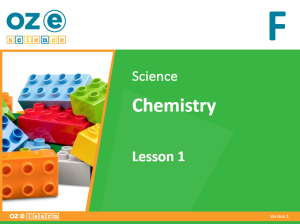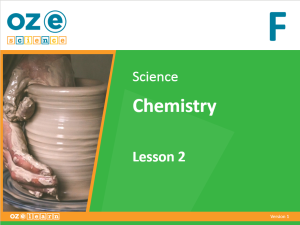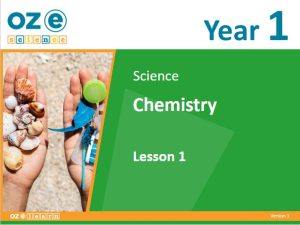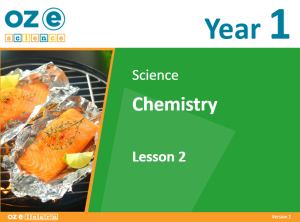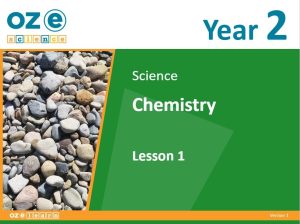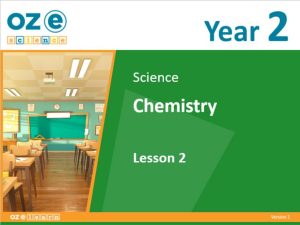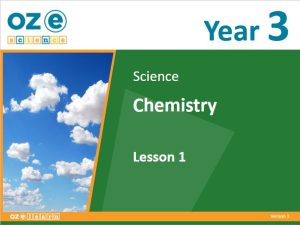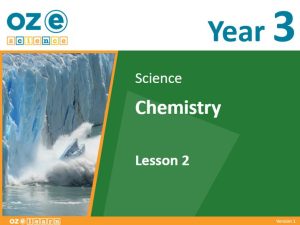Oz-e-science
Chemistry Years F–6
Oz-e-science Chemistry units align to the Australian Curriculum Content Descriptions.
Free Starter Lessons
Year Overview
Australian Curriculum Content Descriptions
Overview
Chemistry Foundation Year is a Chemical Sciences curriculum program for Foundation Year students. It aligns to the Australian Curriculum Science Understanding:
- Everyday materials can be physically changed in a variety of ways (ACSSU018).
Learning Objectives
In Lessons 1 to 9, students learn about:
- materials and the things we make from them
- describing the material a thing is made from
- categorising things made from natural materials
- making something useful from a natural material
- how to identify and classify natural materials that have been changed into new materials by humans
- sorting things that are made from human-made materials
- the properties of materials
- how to describe the properties of materials at discovery stations
- everyday materials with absorbent properties
- experimentation with materials to see which ones have absorbent properties
- everyday materials that have waterproof properties
- experimenting with materials to see which ones have waterproof properties
- different materials used to make shoes for a purpose
- planning and designing an umbrella that protects a gingerbread man from the rain
- making a model, experimenting and recording results to see if the waterproof umbrella protects the gingerbread man from getting wet.
Success Criteria
- Look at the materials that everyday things are made from.
- Describe the material a thing is made from.
- Sort things based on the natural material they are made from.
- Made a model of something useful from a natural material.
- Investigate different types of materials that are human-made and the natural materials they are made from.
- Sort things based on the human-made material they are made from.
- Describe the properties of materials using two senses (touch, sight).
- Describe the properties of materials at discovery stations.
- Look at everyday materials with absorbent properties.
- Experiment with materials to see which ones have absorbent properties.
- Look at the everyday materials that have waterproof properties.
- Experiment with materials to see which ones have waterproof properties.
- Look at everyday materials that are used to make different shoes for a purpose.
- Make a model of a shoe for a purpose.
- Plan a waterproof umbrella design that protects a gingerbread man from the rain.
- Make a model of waterproof umbrellas.
- Experiment to find out if the waterproof umbrellas protect the gingerbread man from the rain and record the results.
Assessment
Progress Tests
Progress tests are conducted after every second lesson, allowing teachers to monitor student understanding of the concepts taught over the past two lessons and to identify where reteaching is needed. The Teaching Guide contains the testing questions, and the Student Workbook has a section where students write their answers and score themselves.
Structured Research Activity
The Structured Research Activity (SRA) for this unit is: Students design and make a waterproof umbrella, experiment on the umbrella and report results. The SRA takes place over two lessons so students can apply the Science Understanding and Science Inquiry Skills covered in the unit. Teachers use the Guide to Making Judgements, which is included in the Teaching Guide, to mark the SRA.
End-of-Unit Assessment
The last lesson is the end-of-unit assessment, which has a variety of question formats (e.g. label the diagram, circle the correct answer) to assess student mastery of content from the unit. The end-of-unit assessment is in the Teaching Guide. Teachers copy the assessment and distribute to students at testing time.
Australian Curriculum Content Descriptions
Overview
Chemistry Year 1 is a Chemical Sciences curriculum program for Year 1 students. It aligns to the Australian Curriculum Science Understanding:
- Everyday materials can be physically changed in a variety of ways (ACSSU018).
Learning Objectives
In Lessons 1 to 9, students learn about:
- materials that they use every day
- sorting everyday objects by what they are made of
- materials that can bend
- making a model caterpillar using the bendable material of metal
- experimenting with a material to learn about stretching
- materials that can be stretched
- materials that can be cut and/or crushed
- experimenting with materials that can be crushed
- how materials change when they are heated.
- experimenting with heating a material
- what happens when wax is cooled
- what happens to materials when cooled
- how Indigenous Australians used heating and cooling to physically change a material
- describing the ways Indigenous Australians physically changed materials
- representing an animal that will be made from air-dry clay and labelling it with the methods used to physically change the air-dry clay
- how to represent a chosen animal by making it out of air-dry clay using stretching, twisting, cutting, bending and crushing to create it
- communicating to the class the methods used to create the animal.
Success Criteria
- Find what materials everyday objects are made from.
- Sort everyday objects by what they are made of.
- Look at materials that can be changed by bending.
- Make a model of a caterpillar using the bendable material of metal.
- Experiments with stretching various materials.
- Measure the length of each of the materials once it has been stretched.
- Find materials that stretch.
- Look at materials that can be cut and/or crushed.
- Experiment crushing a range of materials.
- Look at how materials change when they are heated.
- Experiment by heating a material.
- Observe what happens when water is cooled.
- Predict what happens to various materials when they are cooled.
- Identify how Indigenous Australians used heating and cooling to physically change a material.
- Describe ways Indigenous Australians physically change materials.
- Design and represent an animal that will be made from air dry clay.
- Label the drawing with the ways they will physically change the air-dry clay to create the animal.
- Physically change the air-dry clay to create their animal by bending,
- stretching, twisting, cutting and crushing.
- Communicate the methods used to physically change the air-dry clay to create the animal.
Assessment
Progress Tests
Progress tests are conducted after every second lesson, allowing teachers to monitor student understanding of the concepts taught over the past two lessons and to identify where reteaching is needed. The Teaching Guide contains the testing questions, and the Student Workbook has a section where students write their answers and score themselves.
Structured Research Activity
The Structured Research Activity (SRA) for this unit is: Students design and make an air-dry clay animal, experiment on the animal and report results. The SRA takes place over two lessons so students can apply the Science Understanding and Science Inquiry Skills covered in the unit. Teachers use the Guide to Making Judgements, which is included in the Teaching Guide, to mark the SRA.
End-of-Unit Assessment
The last lesson is the end-of-unit assessment, which has a variety of question formats (e.g. label the diagram, circle the correct answer) to assess student mastery of content from the unit. The end-of-unit assessment is in the Teaching Guide. Teachers copy the assessment and distribute to students at testing time.
Australian Curriculum Content Descriptions
Overview
Chemistry Year 2 is a Chemical Sciences curriculum program for Year 2 students. It aligns to the Australian Curriculum Science Understanding:
- Different materials can be combined for a particular purpose (ACSSU031).
Learning Objectives
In Lessons 1 to 9, students learn about:
- natural materials
- identifying objects that are made from natural materials in the schoolyard or on a scavenger hunt
- human-made materials
- researching materials that are made from atoms
- materials that are combined or mixed
- mixing materials to make slime
- some traditional materials used by Indigenous Australians
- using traditional materials to make art
how materials can be reduced, reused, and recycled - how they can reduce, reuse or recycle in their lunch order
- how we can repurpose and repair unwanted materials
- experimenting to repurpose toilet rolls
- the James Webb Space Telescope
- making a model of the James Webb Telescope
- weatherproof materials
- making a model of a weatherproof shelter
- building the model weatherproof shelter and testing it to see if it will protect the doll from the weather
- making and testing their shelter for its weatherproofing.
Success Criteria
- Find natural materials.
- Sort objects made from natural materials.
- Find materials in the schoolyard that are used to make useful things.
- Find human-made materials.
- Sort things made from human-made materials.
- Inspect human-made materials by looking at the elements on the element table.
- Find materials that are mixed.
- Sort the combined materials in a mixed material.
- Investigate mixed materials by making slime.
- Find materials that are traditional.
- Sort the materials in traditional objects.
- Experiment with traditional materials by making paint.
- Analyse materials that can be reduced, reused, or recycled.
- Sort objects that could be recycled.
- Explain how one can reduce, reuse, and recycle in their own lunch.
- Analyse materials that can be repurposed or repaired.
- Communicate ways that we could repurpose or repair unwanted objects.
- Experiment with toilet rolls to repurpose them as planters.
- Analyse materials that are used in spacecraft.
- Describe the properties of the materials used to make spacecraft.
- Make a model of the James Webb Telescope.
- Analyse materials that are weatherproof.
- Describe the properties of weatherproof materials.
- Make a model of a weatherproof shelter.
- Predict if the model will work against extreme weather.
- Experiment with the model to find out if it can protect from extreme weather.
Assessment
Progress Tests
Progress tests are conducted after every second lesson, allowing teachers to monitor student understanding of the concepts taught over the past two lessons and to identify where reteaching is needed. The Teaching Guide contains the testing questions, and the Student Workbook has a section where students write their answers and score themselves.
Structured Research Activity
The Structured Research Activity (SRA) for this unit is: Students design and make a weatherproof shelter; make predictions and experiment on the shelter and report results. The SRA takes place over two lessons so students can apply the Science Understanding and Science Inquiry Skills covered in the unit. Teachers use the Guide to Making Judgements, which is included in the Teaching Guide, to mark the SRA.
End-of-Unit Assessment
The last lesson is the end-of-unit assessment, which has a variety of question formats (e.g. label the diagram, circle the correct answer) to assess student mastery of content from the unit. The end-of-unit assessment is in the Teaching Guide. Teachers copy the assessment and distribute to students at testing time.
Australian Curriculum Content Descriptions
Overview
Chemistry Year 3 is a Chemical Sciences curriculum program for Year 3 students. It aligns to the Australian Curriculum Science Understanding:
- A change of state between solid and liquid can be caused by adding or removing heat (ACSSU046).
Learning Objectives
In Lessons 1 to 9, students learn about:
- solids, liquids and gases
- classifying solids, liquids and gases
- the particles in matter
- identifying the states of matter based on their properties
- observing what happens when heat is applied to solids and what happens when heat is applied to liquids
- observing what happens when liquids are cooled and what happens when gases are cooled
- how changes in states of matter help recycling
- setting up the solids, liquids and gases experiment
- creating a poster about the solids, liquids and gases experiments.
Success Criteria
- Describe the difference between solids, liquids and gases.
- Observe examples of a solid, a liquid and a gas.
- Describe the states of matter by their particle organisation.
- Represent the particle organisation of solids, liquids and gases.
- Record the changes in state for different materials when heat energy is added.
- Describe the process of heating liquids using different examples.
- Observe (look at) the process of saltwater evaporation.
- Record the changes in state for different materials when we take away heat energy.
- Describe the process of cooling gases using different examples.
- Observe (look at) the process of condensation.
- Describe the states of matter at each step of recycling.
- Plan the steps in the investigation.
- Conduct the experiment (test) and make observations.
- Record the results of an experiment, evaluate it and communicate findings.
Assessment
Progress Tests
Progress tests are conducted after every second lesson, allowing teachers to monitor student understanding of the concepts taught over the past two lessons and to identify where reteaching is needed. The Teaching Guide contains the testing questions, and the Student Workbook has a section where students write their answers and score themselves.
Structured Research Activity
The Structured Research Activity (SRA) for this unit is: Students plan and conduct an experiment observing a solid, a liquid and a gas; develop a poster including observations and evaluation about their experiment. The SRA takes place over two lessons so students can apply the Science Understanding and Science Inquiry Skills covered in the unit. Teachers use the Guide to Making Judgements, which is included in the Teaching Guide, to mark the SRA.
End-of-Unit Assessment
The last lesson is the end-of-unit assessment, which has a variety of question formats (e.g. label the diagram, circle the correct answer) to assess student mastery of content from the unit. The end-of-unit assessment is in the Teaching Guide. Teachers copy the assessment and distribute to students at testing time.
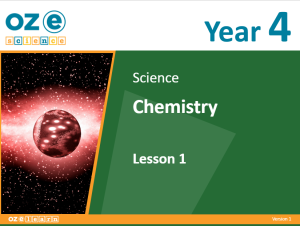
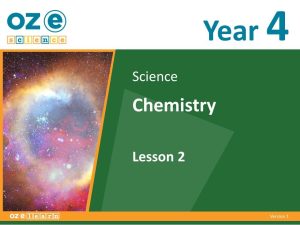
Teaching Resources
Extra resources
Australian Curriculum Content Descriptions
Overview
Chemistry Year 4 is a Chemical Sciences curriculum program for Year 4 students. It aligns to the Australian Curriculum Science Understanding:
- Natural and processed materials have a range of physical properties that can influence their use (ACSSU074).
Learning Objectives
In Lessons 1 to 9, students learn about:
- everything in the universe is made up of very small particles called atoms
- the first two and most common elements in the universe – hydrogen and helium
- some of the first 18 elements of the periodic table
- the physical properties of elements
- the main elements that make up the human body
- the elements that are present in healthcare products and their benefits
- conduct part one of the experiment by following the Scientific Method
- conduct part two of the experiment by following the Scientific Method.
Success Criteria
- Explain the formation of hydrogen and helium.
- Label the parts of a hydrogen and helium atom.
- Identify the first two elements created.
- Represent the first two elements by making a model of their atoms.
- Identify some of the first 18 elements in the periodic table.
- Represent the elements on some playing cards.
- Identify the physical properties of elements.
- Record the physical properties of elements.
- Make a model of the molecular structure of a diamond.
- Identify the physical properties of elements.
- Record the physical properties of elements.
- Identify the main elements in the human body.
- Represent the main elements in an outline of the human body.
- Record the elements in healthcare products.
- Analyse the benefits of the elements in the healthcare products.
- Ask a scientific question.
- Develop a hypothesis.
- Make a prediction.
- Conduct the experiment.
- Make observations.
- Conduct part two of the experiment.
- Record observations.
Assessment
Progress Tests
Progress tests are conducted after every second lesson, allowing teachers to monitor student understanding of the concepts taught over the past two lessons and to identify where reteaching is needed. The Teaching Guide contains the testing questions, and the Student Workbook has a section where students write their answers and score themselves.
Structured Research Activity
The Structured Research Activity (SRA) for this unit is: Students plan, conduct and report on an experiment to test the effectiveness of toothpaste at removing stains.
The SRA takes place over two lessons so students can apply the Science Understanding and Science Inquiry Skills covered in the unit. Teachers use the Guide to Making Judgements, which is included in the Teaching Guide, to mark the SRA.
End-of-Unit Assessment
The last lesson is the end-of-unit assessment, which has a variety of question formats (e.g. label the diagram, circle the correct answer) to assess student mastery of content from the unit. The end-of-unit assessment is in the Teaching Guide. Teachers copy the assessment and distribute to students at testing time.
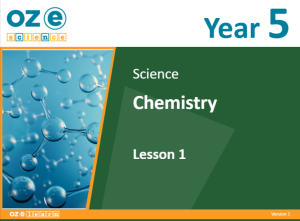
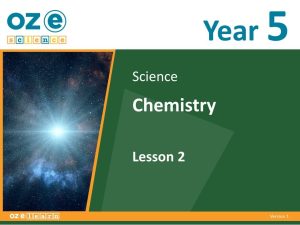
Teaching Resources
Extra resources
Australian Curriculum Content Descriptions
Overview
Chemistry Year 5 is a Chemical Sciences curriculum program for Year 5 students. It aligns to the Australian Curriculum Science Understanding:
- Solids, liquids and gases have different observable properties and behave in different ways (ACSSU007).
Learning Objectives
In Lessons 1 to 9, students learn:
- how to identify and represent molecules
- different elements according to when they first formed in the universe
- how molecules are arranged in solid, liquid and gas
- the properties of common compounds that are solid at room temperature
- the properties of liquids are room temperature
- properties of gases at room temperature
- how to set up an experiment to investigate and communicate how growing crystals change the state of matter.
Success Criteria
- Explain what molecules are.
- Describe at least four common molecules.
- Represent one common molecule.
- Describe three ways in which elements are formed in the universe.
- Identify and sort elements according to when they first formed in the universe.
- Describe the formation of molecules in solid, liquid and gas.
- Describe the properties of solid elements.
- Identify the properties of solid elements.
- Report the best material to use to create a drinking cup.
- Describe the properties of solid compounds.
- Identify the properties of common solid compounds.
- Compare the properties of solid compounds.
- Describe the properties of liquid.
- Compare the properties of different liquids.
- Observe how the density of liquids affects them.
- Describe the properties of gas.
- Explain that some gases are essential for survival.
- Observe that gas molecules fill the space that they are in.
- Experiment with growing crystals.
- Investigate how different materials grow different crystals.
- Observe the experiment set-up on day one.
- Observe the crystals grown in the experiment.
- Plan how to grow crystals at home.
- Predict and hypothesise which crystals will grow best at home.
Assessment
Progress Tests
Progress tests are conducted after every second lesson, allowing teachers to monitor student understanding of the concepts taught over the past two lessons and to identify where reteaching is needed. The Teaching Guide contains the testing questions, and the Student Workbook has a section where students write their answers and score themselves.
Structured Research Activity
The Structured Research Activity (SRA) for this unit is: Students plan, conduct and report on an experiment to describe how the observable properties of crystals behave and grow in different ways. The SRA takes place over two lessons so students can apply the Science Understanding and Science Inquiry Skills covered in the unit. Teachers use the Guide to Making Judgements, which is included in the Teaching Guide, to mark the SRA.
End-of-Unit Assessment
The last lesson is the end-of-unit assessment, which has a variety of question formats (e.g., label the diagram, circle the correct answer) to assess student mastery of content from the unit. The end-of-unit assessment is in the Teaching Guide. Teachers copy the assessment and distribute to students at testing time.
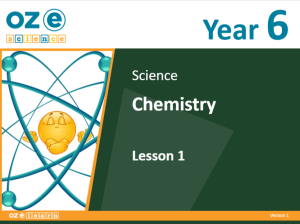
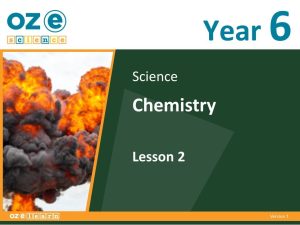
Teaching Resources
Extra resources
Australian Curriculum Content Descriptions
Overview
Chemistry Year 6 is a Chemical Sciences curriculum program for Year 6 students. It aligns to the Australian Curriculum Science Understanding:
- Changes to materials can be reversible or irreversible (ACSSU0950).
Learning Objectives
In Lessons 1 to 9, students learn about:
- electrons
- how some atoms share electrons and bond together
- how some atoms are highly reactive while others are happy as they are
- how objects and chemical elements can be sorted by their properties
- how elements are sorted into the Periodic Table of Elements by their properties
- the physical changes of materials
- the chemical changes of materials
- how to conduct an experiment using the scientific method
- presenting the findings of their experiment.
Success Criteria
- Explain what electrons are.
- Describe where electrons can be found in different elements.
- Represent the number of electrons in an electron game.
- Explain how atoms can give or take electrons from other atoms.
- Describe how giving and taking electrons leads to atoms and bonding.
- Represent how atoms bond in the electron bonding game.
- Explain why some atoms are more reactive than others.
- Sort atoms by their reactivity.
- Describe how objects can be sorted into tables by their properties.
- Describe how elements are sorted into the Periodic Table of Elements.
- Sort elements into the period table by their properties.
- Predict where elements might be placed in the Periodic Table.
- Explain what happens when a material physically changes.
- Describe what happens to the molecules when physical change occurs.
- Predict what happens when slime is physically changed.
- Explain what happens when a material chemically changes.
- Describe what happens to the molecules when chemical change occurs.
- Predict what happens in an everyday reaction.
- Ask a question, develop a hypothesis, predict an outcome for an experiment, and observe to understand which liquids can make iron rust.
- Observe, evaluate and explain our experiment to understand which liquids can make iron rust.
Assessment
Progress Tests
Progress tests are conducted after every second lesson, allowing teachers to monitor student understanding of the concepts taught over the past two lessons and to identify where reteaching is needed. The Teaching Guide contains the testing questions, and the Student Workbook has a section where students write their answers and score themselves.
Structured Research Activity
The Structured Research Activity (SRA) for this unit is: Students plan, conduct and report on an experiment baking cookies to observe how changes to materials can be reversible or irreversible. The SRA takes place over two lessons so students can apply the Science Understanding and Science Inquiry Skills covered in the unit. Teachers use the Guide to Making Judgements, which is included in the Teaching Guide, to mark the SRA.
End-of-Unit Assessment
The last lesson is the end-of-unit assessment, which has a variety of question formats (e.g. label the diagram, circle the correct answer) to assess student mastery of content from the unit. The end-of-unit assessment is in the Teaching Guide. Teachers copy the assessment and distribute to students at testing time.

